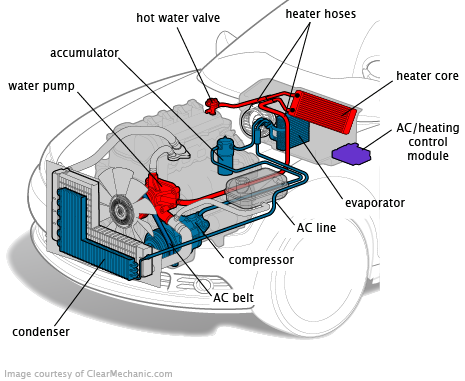Blog

How To Diagnose An A/C Problem
Having your car’s air conditioning go out suddenly can ruin your day fast. The most common causes of broken air conditioning are leaks or compressor issues. If your air is blowing cool but not cold, the problem could be a clogged filter, cooling fan problem or radiator trouble. Don’t tolerate a stuffy, uncomfortable car. Use our guide below to diagnose your specific climate control problem, and you could save yourself some cold cash on the fix.
Cool But Not Cold
If the air conditioning is set to max cool and fans on high, but is only blowing moderately cool air:
Check to see that the cooling fans on the condenser or radiator are running when the air conditioning is on.
Look for any restrictions like leaves, bugs or dirt that would keep air from passing over the condenser.
Check the cabin air filter to ensure that it is not clogged.
Check the pressures in the system using a manifold gauge set. The recommended high-side and low-side pressures can be found in the repair manual.
Compressor
When diagnosing an air conditioning issue, it's easiest to begin at the compressor.
With the engine running turn the A/C on max cool, set fans high, and make sure that the clutch is engaging on the compressor.
Note: this is not the pulley, but the center piece that engages the pulley to the compressor shaft. If the clutch is engaging and disengaging rapidly, the refrigerant may be low.
If the clutch is not engaging, use a voltmeter to check for voltage getting to the compressor.
If there is voltage - the clutch may be bad.
If there is no voltage - a cycling switch may be bad, a fuse may be blown and the system may not have enough refrigerant pressure to trip the low pressure cutoff switch that cycles the compressor.
Leaks
Leaks are the most common problem associated with the air conditioning system.
If pressure is low, then there may be a leak.
Using a UV A/C leak detection kit is the easiest way to find a leak.
Follow the instructions on the packaging to introduce UV dye to the system and UV light to find the leak.
Check around all fittings to verify that they are all secure.
Check hose manifolds on the compressor.
Check the front seal and the o-rings sealing the pressure switches on the back of some compressors.
Check where the hoses are crimped onto the fittings.
Check the Schrader Valves.
Check for pin holes in the condenser.
Check where the evaporator drains condensation with UV light. Sometimes oil or dye can be seen.
Note: The dye check will not work if the system is too low and the compressor is not cycling.
Posted on July 2017,26 // Author: Admin